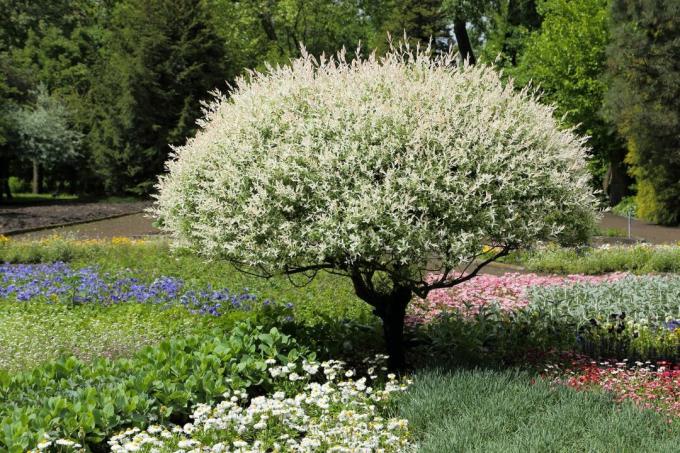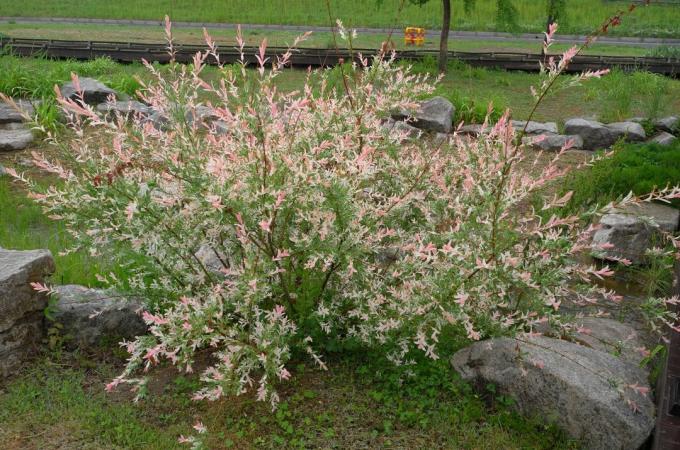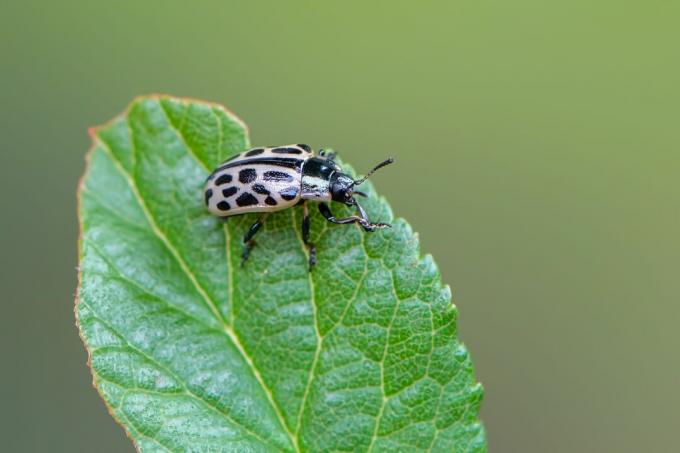With its colorful foliage, the harlequin willow attracts everyone's attention. The East Asian willow rarely blooms, but the real attraction is the colorful shoots of leaves in spring.

Harlequin willow is not only good for its easy-care handling (Salix integra) every gardener's delight. Thanks to its white and pink leaf dress, which changes over the course of the year, it is a real eye-catcher in every garden. You can find out what a suitable location looks like and what you should consider when maintaining it here.
contents
- Harlequin Willow: size, flowering and characteristics
- Planting harlequin willow: location, timing and procedure
- Maintain harlequin pasture
- Propagate harlequin willow
- Hibernate harlequin willow
- Common harlequin willow pests and diseases
- Is the harlequin willow poisonous?
Harlequin Willow: size, flowering and characteristics
The Harlequin Willow (Salix integra ‘Hakuro Nishiki’), or Japanese ornamental willow, is also called multi-leaved willow or flamingo tree due to its particularly beautiful, white-pink variegated leaf dress. It belongs to the willow family (
Salicaceae).It originally comes from East Asia and is common throughout Japan, Korea and northern China. The harlequin willow is particularly popular as a shrub or high-stemmed tree. The ornamental willow can reach a height of up to 3 meters and an average width of 1.5 meters. The harlequin willow is in bloom between March and April. The inconspicuous yellowish kittens appear before the leaves and offer plenty of food for insects early in the year. The shoot of the new leaves is often mistaken for the actual flower. The elongated, oppositely arranged leaves on the red young shoots are initially patterned white and pink. That is why they look like colorful flowers in front of the green-white discolored shoots. This effect is particularly splendid when the harlequin willow is in the sun. The frost-hard, deciduous plant forms shallow roots, which is why it can be kept well in the tub.

Tip: When cultivated as a high trunk, it is grafted onto the trunk of another type of willow so that it reaches an optimal trunk height. The trunk of the harlequin willow is fully grown when you buy it and is available in different sizes.
Planting harlequin willow: location, timing and procedure
In order to be able to admire the unusual play of colors of the leaves, you should look for a location in the sun for the harlequin willow. A partially shaded place is also suitable, but it should not be completely shady. Like all willows, it prefers loose, humus-rich, moist and cool soil and, thanks to its shallow roots, can also be planted in pots. The vessel should be large and glazed so that the earth does not dry out so quickly. A loose and high-quality potting soil like ours is suitable as a substrate Plantura organic universal soil. It can be used in pots or mixed into sandy garden soil. The pasture benefits from the compost it contains, and our soil also promotes healthy soil life in the bed.
The best time to plant harlequin willow is in fall or spring. So the roots are not directly exposed to the summer drought. After planting, the harlequin willow should be watered abundantly. If you want to plant the harlequin willow as a high trunk, it is best to tie the trunk in a permanently stable manner so that the trunk does not crack in strong winds.
Tip: For those for whom a pink willow in the garden is not enough, the willow can also be cultivated as a hedge. A planting distance of 50 - 60 cm should be maintained so that the roots have enough space to grow. The fast-growing willow hedge is up to 1.5 m high and with regular pruning you can enjoy the colorful budding every year.
Maintain harlequin pasture
The harlequin willow is considered to be an extremely easy-care plant. Nevertheless, it occasionally needs water and fertilizer as well as a pruning so that it can continue to present its beautiful foliage.
At the Cutting willows there are a couple of things to keep in mind. The best time to prune is in spring. But if you want to keep the flowers for insects, the pruning should be done a little later, after the flowering time in April.
Here's how to go about pruning your harlequin willow:
- Remove shoots from the trunk
- Cut off dead, crossing and diseased branches at the base
- Shorten all shoots by two thirds
- Always cut above a bud
- Harlequin willow bushes can also be cut back radically in autumn so that only a few stumps remain
- Do not injure the grafting points on tall trunks
- Trim in summer if necessary

tip: Willows sprout again very quickly and can therefore be cut back a lot. Most of the colorful leaves are on the young, newly emerging shoots.
The substrate of the harlequin willow dries up relatively quickly, especially in pots and tubs. You should preferably water the willow so that the soil is moist, but no waterlogging occurs, as this is very harmful to the roots. Especially in midsummer, it is advisable to check regularly whether the soil is still damp. Otherwise, rain water or lime-free water should be poured in.
Container plants also benefit from annual fertilization in spring around the time the leaves are sprouting. A complete fertilizer like ours Plantura organic universal fertilizerr lasts a long time and provides the harlequin willow with sufficient nutrients for a long time. Our biological fertilizer is primarily organic and harmless for pets and garden animals.

Harlequin willows in the bucket also need a new planter from time to time, as they form a large root ball and require more space. The fresh substrate is also conducive to growth. If the root ball grows out of the pot or if the harlequin willow no longer grows properly, it is time for a new pot. It is best to repot in autumn. Be careful not to damage any roots. You can also transplant the harlequin willow and, if necessary, move it to a more suitable location in the garden. When repotting comes again a nutrient-rich, slightly acidic potting soil and a well-balanced complete fertilizer like ours Plantura organic universal fertilizer for use. The latter works for several months and constantly releases all essential nutritional elements.
Propagate harlequin willow
The propagation of the harlequin willow and many other types of willow is basically very easy. You can use cuttings or cuttings to propagate the harlequin willow. To create an offshoot yourself, bend a branch of the bush so that it rests on the ground. Secure the branch with a stone or metal peg, pile some soil in the center of the branch and keep everything moist. If the offshoot has formed many roots after a year at the latest, it can be separated from the mother plant. This creates a shrub-like harlequin willow.
Propagating cuttings is just as easy. The best way to do this is to put the branches that have been cut back in a vase with water and wait for roots to form. The rooted young willows should then be planted in a pot with a mixture of soil and sand before they are planted out.

If you want to cultivate a harlequin willow tree as a high trunk, you have to refine the branch on a previously grown willow trunk. This, however, requires a little practice and unfortunately the refinement does not always succeed. The suitable technique is winter hand finishing. For this purpose, young shoots of the harlequin willow are cut off in autumn and grafted onto the substrate. Suitable underlays are, for example, wicker (Salix viminalis) or ripe willow (Salix daphnoide). These can be shortened to the desired height directly before grafting - this is how the height of the willow trunk is determined. A gap about 4 cm long is cut into the cut with a sharp knife. Now you need a shoot of harlequin willow, which is grafted onto the base. It should have the same diameter as the base, otherwise the adhesion will be difficult. The lower end is now cut like a wedge that fits exactly into the gap in the pad. The noble rice is stuck firmly into the base and wrapped tightly with raffia to fix it. The interfaces are then coated with tree wax. It is best to place the plant in an evenly warm and bright place.
Hibernate harlequin willow
If you have decided to plant the harlequin willow in a tub, you have to protect it additionally in winter. It is therefore an advantage to wrap the pot in bubble wrap, fleece or a jute sack. Then place the willow in a sheltered place.
Harlequin willows planted in natural soil do not need more than a layer of mulch over the garden soil to protect against permafrost. Otherwise the pasture is considered hardy and generally overwinters without any problems.

Common harlequin willow pests and diseases
The harlequin willow is rather insensitive to pests and diseases, but there are a few exceptions:
- Brown leaf tips: If the harlequin willow gets brown leaf tips, it is usually due to too much or too little water. If so, check the soil and adjust the watering.
- Willow Borer (Cossus cossus): If the harlequin willow is attacked by pests, it is often the willow borer. Its larvae are easy to recognize because they are white to dark red and live in the wood, clearly visible. As a symptom, the leaves of the willow usually curl. You should cut off the affected branches generously and burn them, as the willow borer lives on in the dead wood and can re-infect the plant after pupation.
- Spotted willow leaf beetle (Chrysomela vigintipunctata): If your willow shows signs of eating, it could be the spotted willow leaf beetle, which you can also fight by cutting back the branches.
- Fungal attack: A fungal infestation with rust fungi or anthracnose is characterized by black-brown spots on leaves and branches. They appear burned and need to be cut back generously.

Is the harlequin willow poisonous?
In principle, the harlequin willow is not considered to be poisonous. However, the bark and shoots contain tannins that are released if a dog or cat chews on them for a long time. These tannins can then lead to digestive disorders. It convinces with less conspicuous foliage, but with spectacular flowers in spring Judas tree. We give tips and tricks on location and care.
